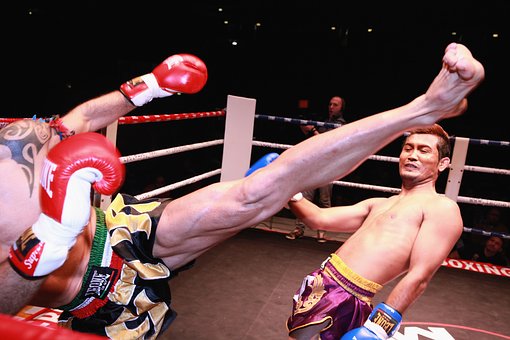Muay thai employs a lot of kicks to the body, legs and head of your opponent, as well as using your shins to check and block your opponents kicks.
So as a muay thai practitioners you really need to spend some time on muay thai shin conditioning.
Especially early on in your muay thai journey it is important to put in the work on your muay thai shin conditioning as it takes quite a long time to build up.
Eventually with effective muay thai shin conditioning methods from this post you will be able to damage your opponent with kicks and also make them feel pain and think twice about kicking you with your solid blocks and checks using your shins.
- So what are the best ways to go about muay thai shin conditioning?
- What are the methods used by the Thais to condition their shins?
- Also what are some of the myths and falsehoods out there regarding shin conditioning?
These are some of the questions that will be discussed in this post as well as providing 5 effective muay thai shin conditioning tips that are proven to work.
But first, let’s look at some of the wrong ways to do muay thai shin conditioning.
Muay Thai Shin Conditioning – No-no’s (especially for beginners). How NOT to do it.
Let’s start with some of the not so good muay thai shin conditioning practices out there that can be unnecessary.
And while they may work, for a beginner or someone who wants to take care of their shins in the long run these may not be the best ways to get them in good condition for muay thai.
Kicking Trees and Hard Objects
You’ve probably seen Van Damme in ‘Kickboxer’ kicking trees as part of his training in Thailand.
But this is mostly myth and a dramatic scene for the movies.
In reality without first putting time in conditioning your shins and then trying to kick trees and other heavy objects you could very likely break your shin bone and cause serious damage to yourself.
Rolling hard objects over your shins or striking them with wooden bats
This is another way of conditioning shins that is probably unnecessary and also can really injure your shins and keep you out of training which is really not good as it’s training muay thai where you will make the most progress and improvement.
And missing training because of hurt shins due to unnecessary shin conditioning methods really isn’t smart.
Check out the video below to see the wrong way to go about conditioning your shins. Do not try this!
While iron body training in kung fu does employ such methods or whacking your body with wooden poles to toughen them up, in Thailand because fighters fight so regularly they tend to take a more careful and sustainable approach to conditioning their shins.
So let’s look at the better way to condition your shins for muay thai.
Below are 5 important methods for muay thai shin conditioning that can be trained by beginners and professional fighters over the long run.
Remember that no matter how much training you do, your shins will still hurt if you fight and spar a lot. Especially if you get your low kick checked – it will hurt! Guaranteed.
So please take care of your shins after each training session make sure they get good rest and recovery.
Included below also are 3 tips to keep your shins in good condition for muay thai.
The Right Way to do Muay Thai Shin Conditioning – 5 Training Methods
1. Kick the heavy bag a lot
This is it. The number one tip especially for a beginner and someone who trains at home or solo a lot.
If you can, kick the heavy bag up to 5 days a week. The Thai camps train twice a day six days a week with a lot of rounds kicking the heavy bag.
Over time this will condition your shins. Especially like for the Thais if you start training from a very early age and kick the bag many, many times over the course of years.
2. Road running
Road running is something the Thais do a lot.
Especially for active fighters, a normal training session will begin with running anywhere between 3-10km and this can be done twice a day before each session, 6 days a week.
As you know runners often develop shin splints and micro fractures in the shin bone which over time heal over and lead to strengthening the shin bone and making it stronger.

This is another solid method that will help to condition your shins and something that the Thais do a lot.
3. Sparring without shin guards
The Thais often do a lot of sparring without shin guards.
This is mainly light sparring working on technique and speed and timing. This type of sparring is very playful but when done a lot it really helps to condition your shins and you learn to be wary and not kick your partners blocks.
Something which is easy to get in the bad habit of doing when you spar a lot with shin guards is kicking your partners blocks and checks. Sparring without shin guards even lightly will help you remember this lesson.
4. Jumping rope
After completing their warm up runs before training, typical muay thai training sessions in Thailand will then involve up to 30 minutes of jumping rope.
When starting out for a beginner 1 – 3 rounds of 5 minutes is a good place to start and will go a long way to strengthening your legs, calves and shins.
The effect on the shins is similar to the running impact on shins in that it breaks down the shin bone through tiny micro fractures that will heal up and make your shin bone denser and stronger.
This makes jumping rope a great muay thai shin conditioning exercise also and something done everyday in Thailand fight camps where they use the thicker muay thai skipping ropes.
5. Foam rolling your shins
The use of the foam roller alone on your shins can be quite painful at first.
But over time as you foam roll and get the kinks and knots and blocked up areas in your shins loose and free up movement it will get less painful and will help in conditioning your shins also.
So implementing the 5 shin conditioning for muay thai methods discussed above, over time will go a long way to improving the conditioning, bone density and strength of your shins.
3 Tips to Take Care of Your Shins
Here are 3 Tips to keep your shins in good shape and to take care of them well and to remain consistent in your shin conditioning especially when starting out.
I) Take your time
Understand that it takes a long time to condition your shins for muay thai and when you first start out, just by kicking the heavy bag and thai pads a lot your shins will hurt.
But over time if you remain consistent and stick with it over weeks, months and years your shins will get more conditioned.
Just know that they will still hurt if someone blocks your kicks with their shin!
But over time you will get tougher and your timing will improve as well as feints and fakes to be able to get your kicks off without your opponent being able to block you all the time.
II) Treat Your Shins with Hot Water and Hot Oil Rub downs
This will also help your shins to recover after training and fighting and will help to keep your shins in decent shape and be able to recover after breaking them down with hard training.
Check out Sylvie’s video below on treating bumps and injuries to your shins from hard training, sparring and fighting. Sylvie is a veteran of 300 fights in Thailand and her expertise and advice should be noted for proper shin treatment.
III) Nutrition is Important
Make sure you are getting enough calories overall as well the right nutrients, vitamins and minerals necessary to be able to sustain your training over the long run.
Getting sufficient calcium for bones and the necessary Vitamins such as Vitamins C and D that help the body produce collagen to help with bone repair and recovery.
So paying attention to your nutrition is very important especially if your training hard regularly.
Summary – Muay Thai Shin Conditioning
So all in all shin conditioning for muay thai takes time to develop.
When starting out as a beginner its important to remember that as well as the fact that your shins will still continue to hurt no matter how conditioned they are.
I hope the 5 shin training methods and 3 shin care tips in this post will help you toward strengthening and conditioning your shins and taking care of them so they serve you well in your muay thai journey.



